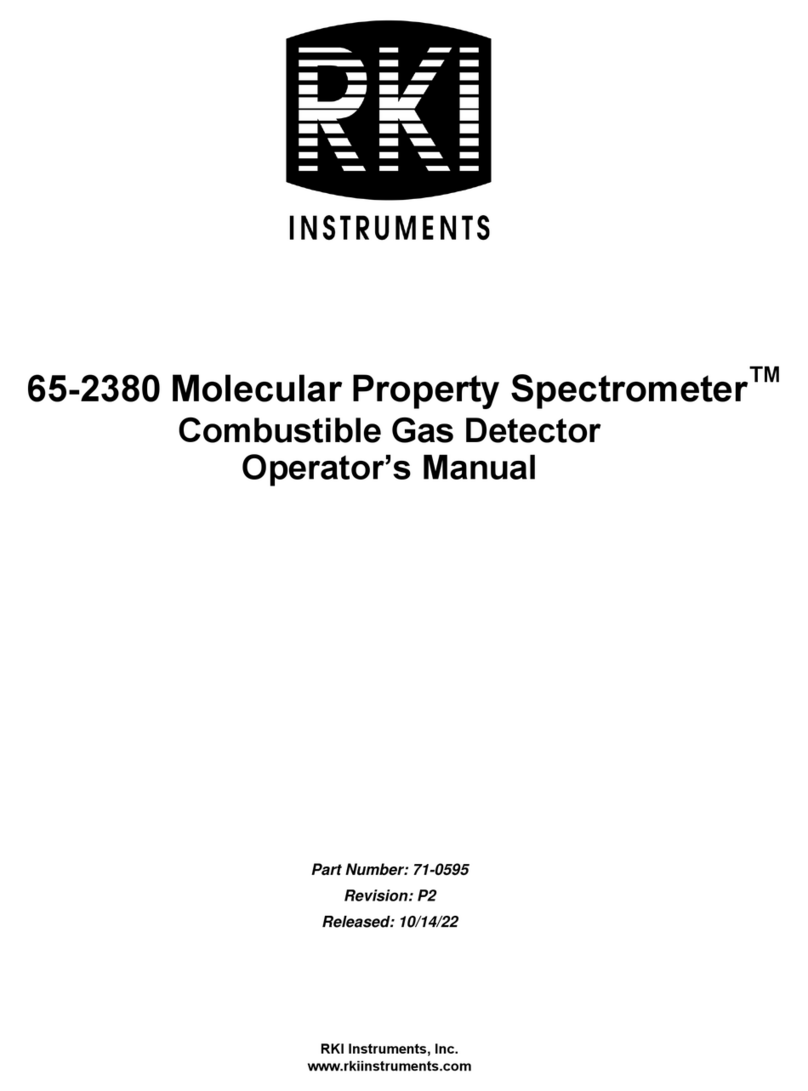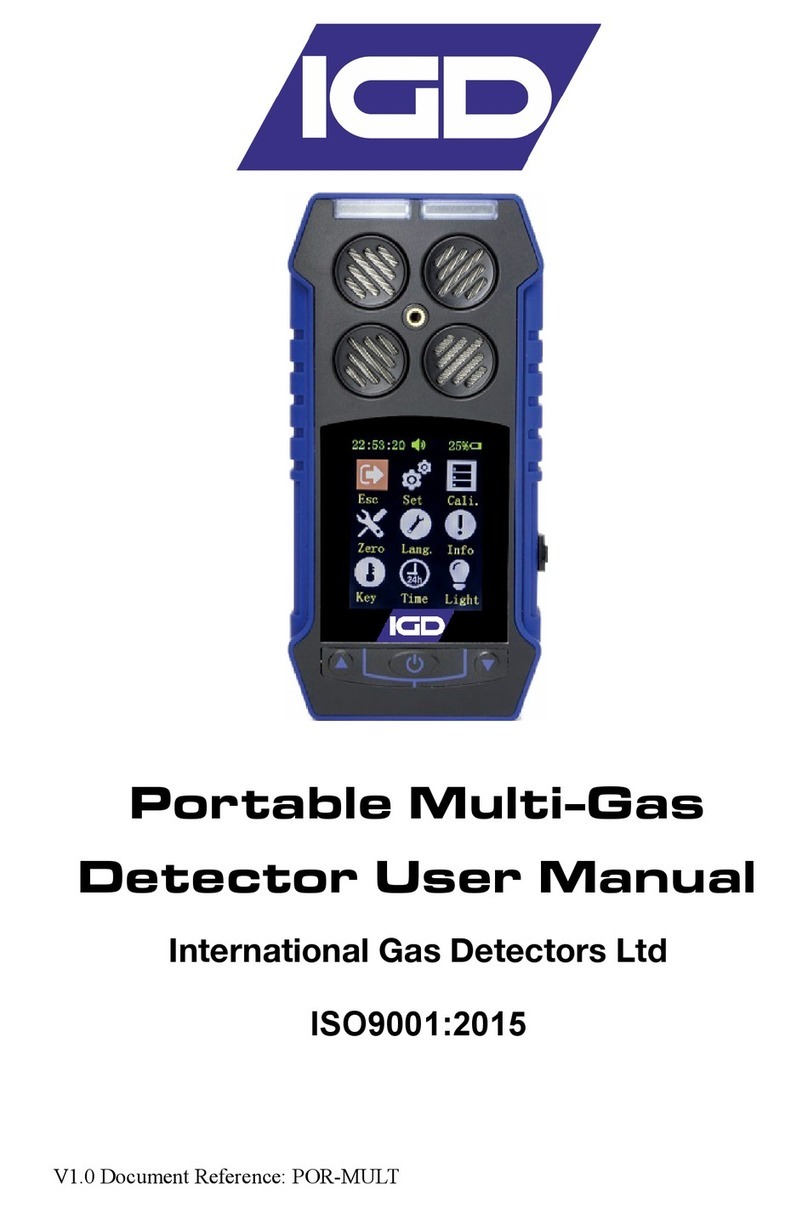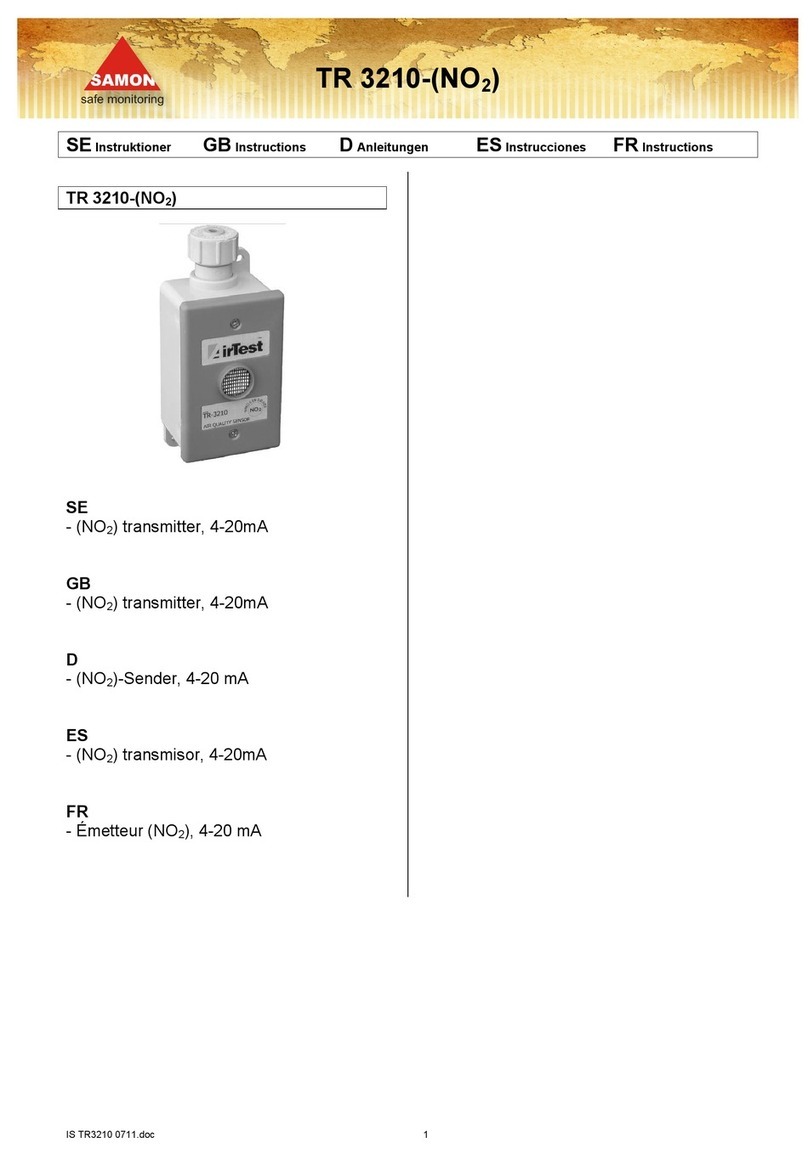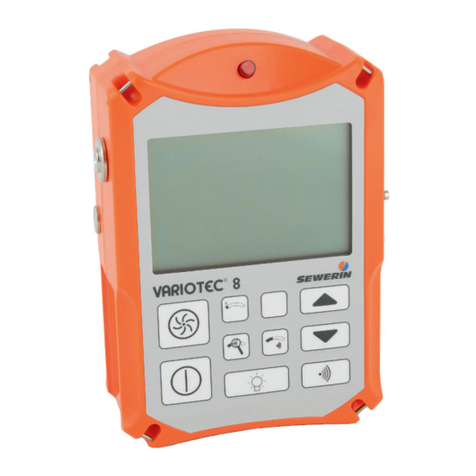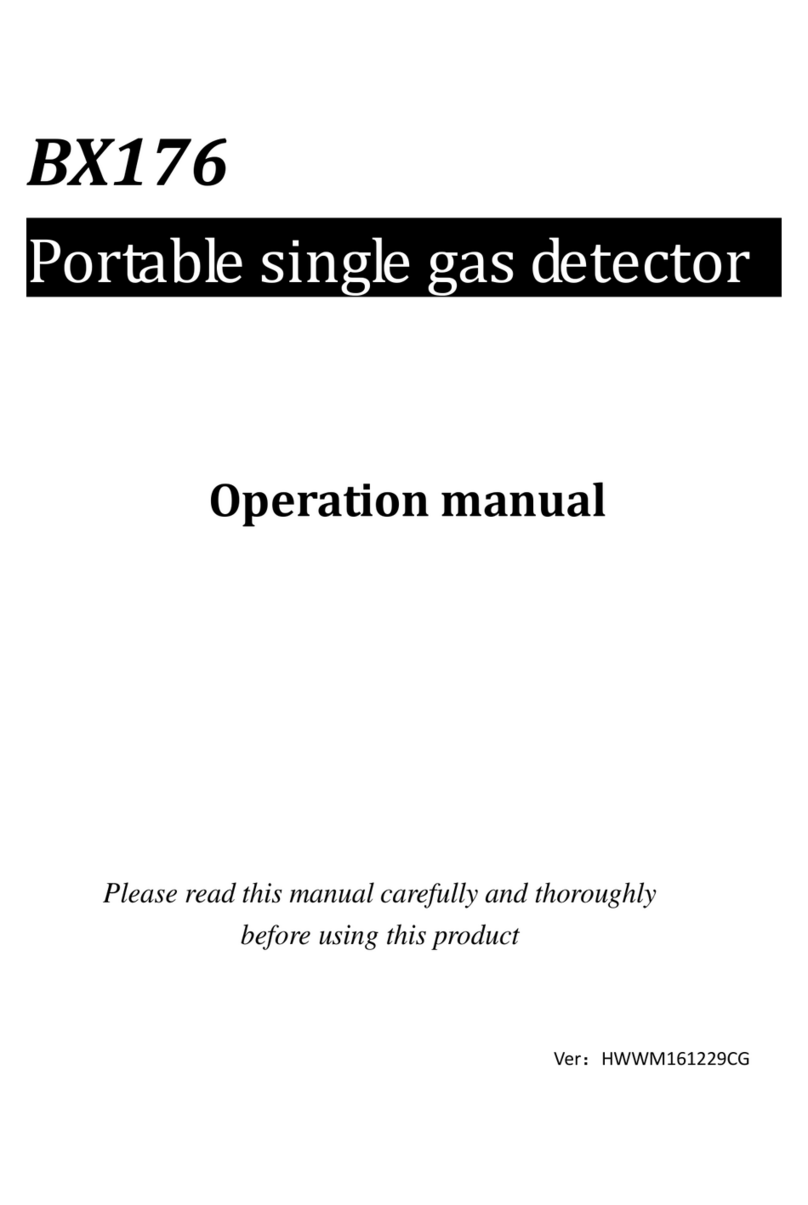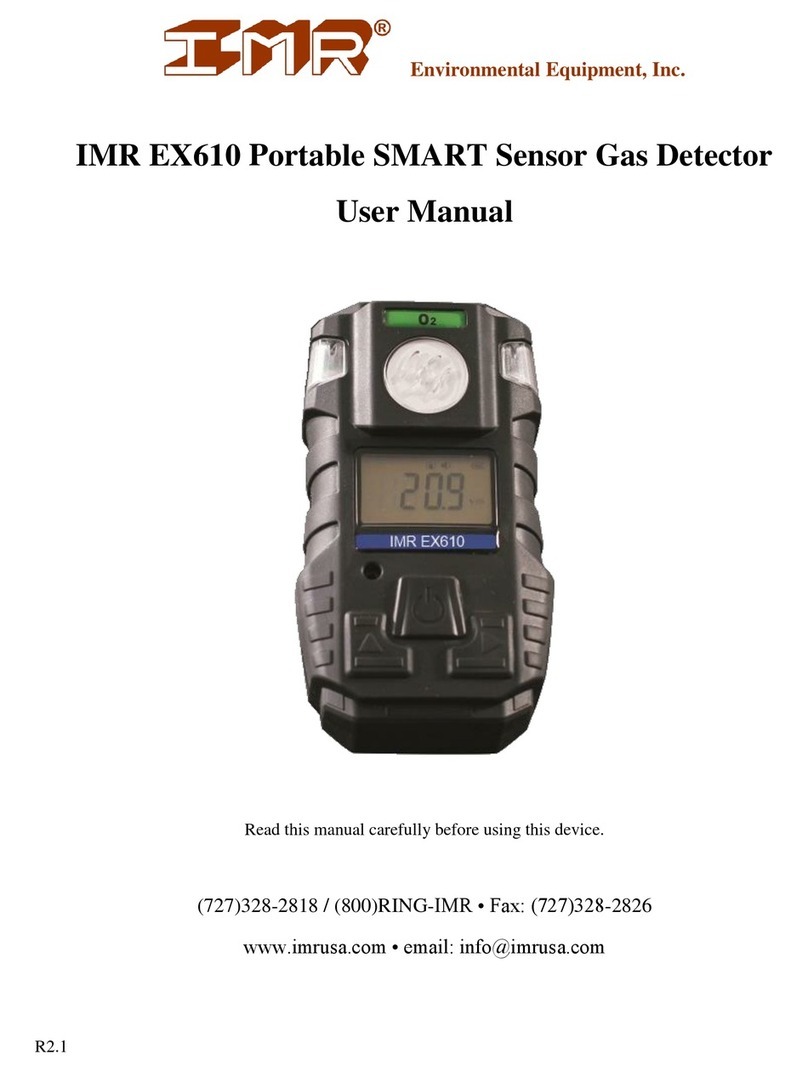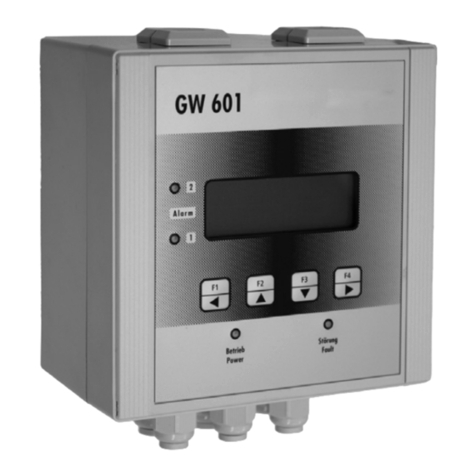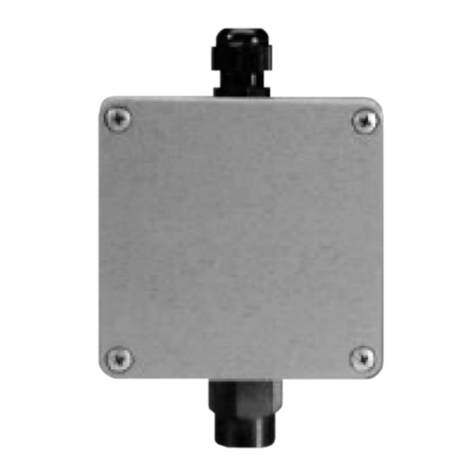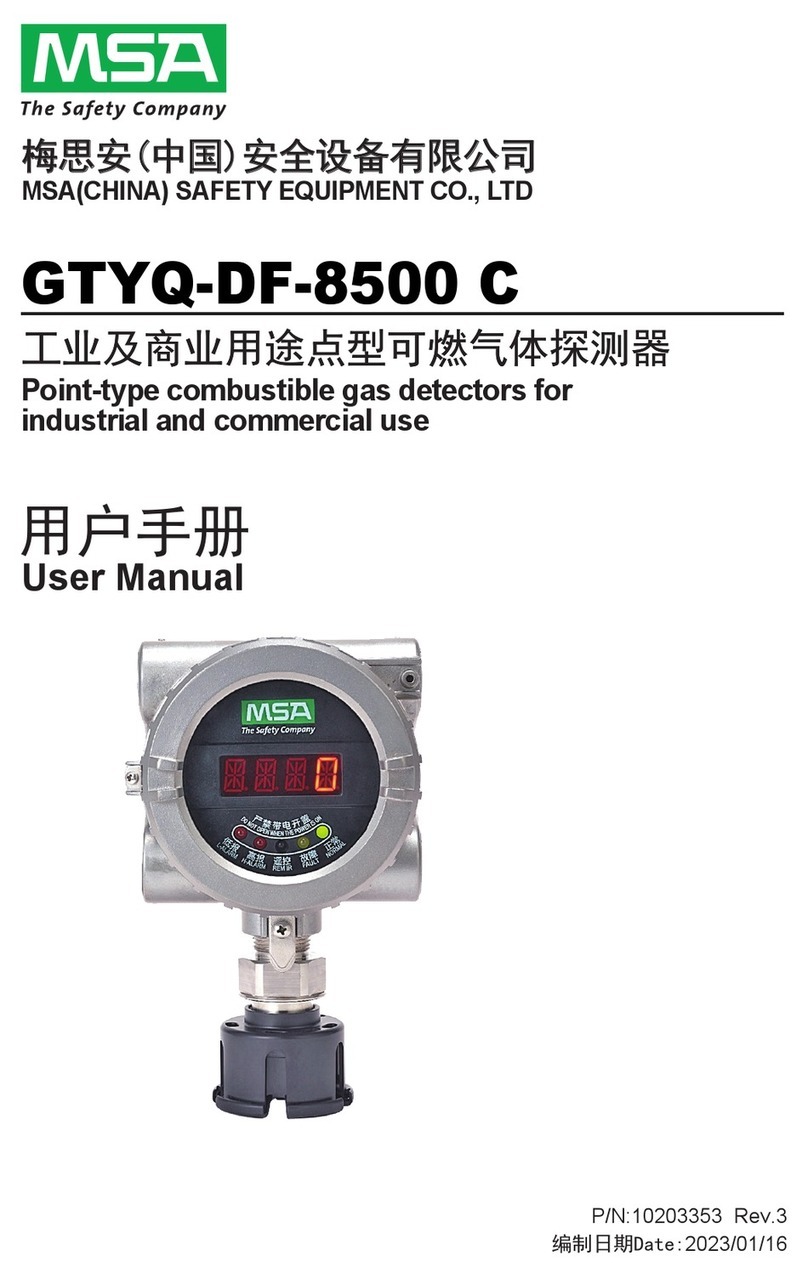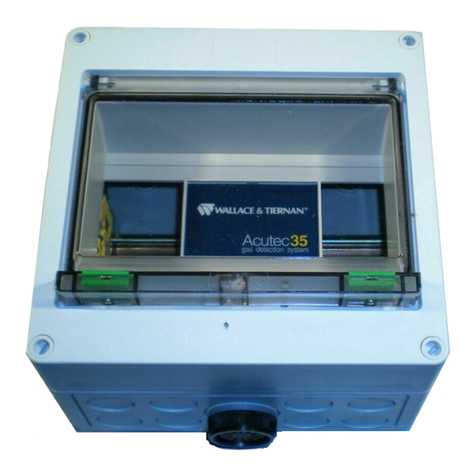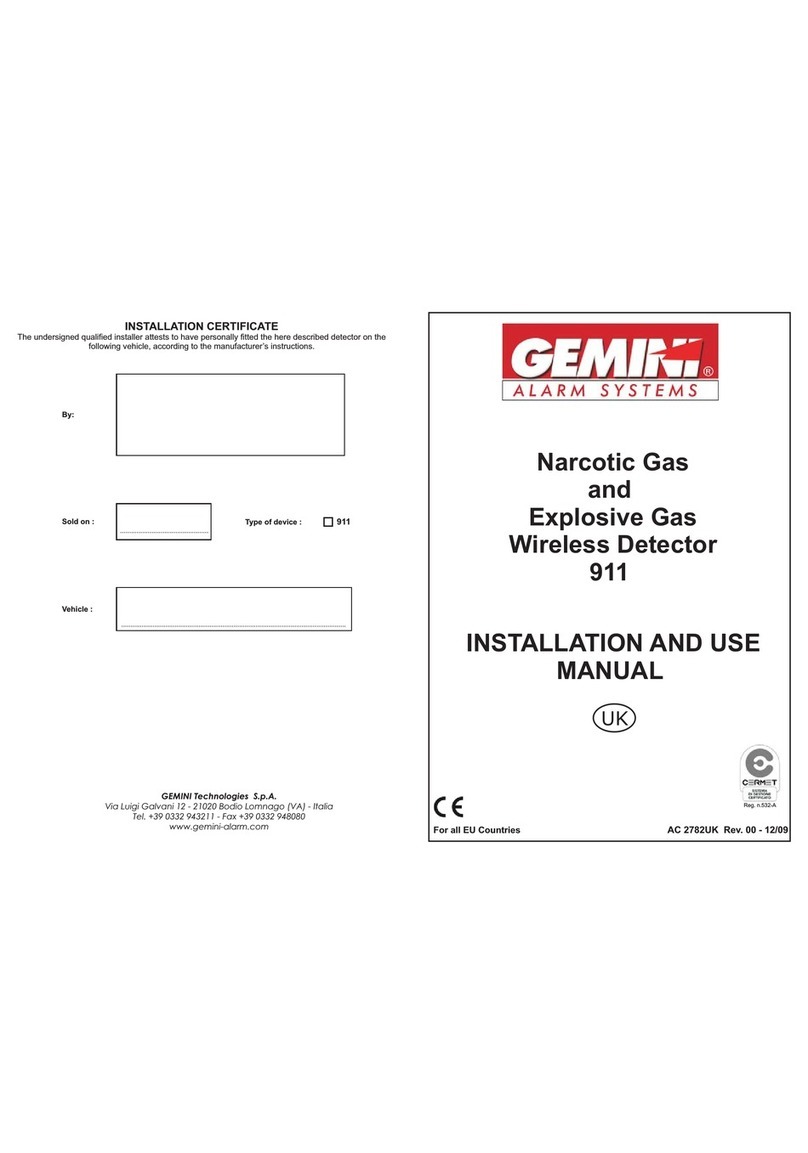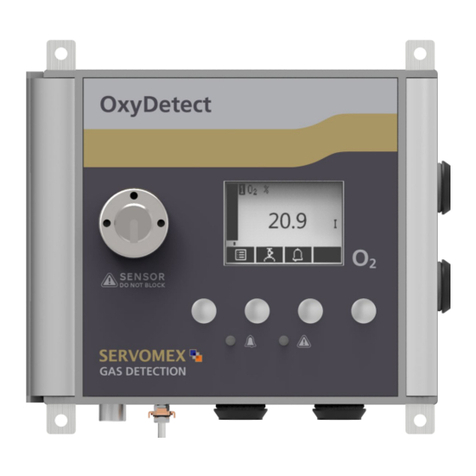STATUS SCIENTIFIC CONTROLS FGD2 User manual

STATUS SCIENTIFIC CONTROLS
Issue:
8
Date:
14/10/19
Version:
9.6P
FGD2 & 3
Atex Flammable
Gas Detector Heads
STATUS SCIENTIFIC CONTROLS LTD.
Hermitage Lane Industrial Estate,
Kings Mill Way,
Mansfield,
Nottinghamshire.
NG18 5ER
England
Tel
Fax
: 01623 651381
: 01623 421063


Declaration of Conformity
Description of Equipment:
The FGD1-3 Series of Fixed Gas Detectors for the detection of Oxygen, Toxic or Flammable gases.
ATEX Certified intrinsically safe for use in Group IIC hazardous locations.
Directive 2014/34/EU ATEX
The following harmonised standards were used in support of this declaration:
Harmonised Standards:
EN60079-0:2018 Explosive atmospheres - Part 0: Equipment - General requirements.
EN60079-1:2014 Explosive atmospheres - Part 1: Equipment protection by flameproof enclosures “d”.
EN60079-11:2012 Explosive atmospheres - Part 11: Equipment protection by intrinsic safety “i”.
Notified Body for Hazardous Area Certification:
SGS Fimko Oy
Särkiniementie 3
Helsinki, 00211
Notified Body Number: 0598
Notified Body for ATEX Quality Assurance Notification:
SGS Fimko Oy
Särkiniementie 3
Helsinki, 00211
Notified Body Number: 0598
Hazardous Area Certificate Number:
Baseefa 01ATEX2300 II 2 G Ex ia IIC
T4 Gb (-20OC ≤Ta≤+60O C)
ATEX Quality Assurance Notification Number:
2056
Place of Manufacture:
Mansfield, Nottinghamshire, UK. Date mark applied –see product
ISO 9001:2015 Quality Management System:
Certificate No. GB93/1938
2014/30/EU –Electromagnetic Compatibility
Harmonised Standards:
EN50270:2006 Electromagnetic compatibility - Electrical apparatus for the detection and measurement of combustible gases, toxic gases
or oxygen.
Authorised Signatory to this declaration, on behalf of the manufacturer:
Name: David Stuttard Title: Managing Director
Address: Status Scientific Controls Ltd, Hermitage Lane Industrial Estate, Kings Mill Way
Mansfield, Nottinghamshire, NG18 5ER, United Kingdom
Signature Date: 14/10/19
Extract from TD06/110

STATUS SCIENTIFIC CONTROLS
FGD2 & 3 Flammable Gas Detector Heads
FGD2 Atex Gas Detector Head
FGD3 Atex Gas Detector Head

STATUS SCIENTIFIC CONTROLS
FGD2 & 3 Flammable Gas Detector Heads
1INTRODUCTION...............................................................................1-1
1.1 INSTALLATION .............................................................................1-1
1.1.1 Siting the Sensors...............................................................1-1
1.1.2 Wire Termination.................................................................1-2
1.1.3 Cable Routing......................................................................1-2
1.1.4 Cable & Screening ..............................................................1-2
2INSTALLATION IN A NON-HAZARDOUS LOCATION....................2-1
2.1 INSTALLATION IN A HAZARDOUS LOCATION.....................................2-2
2.2 INSTALLATION USING PROPRIETARY SAFETY BARRIERS...................2-3
3MENU MODE SELECTION...............................................................3-1
3.1 ZERO SENSOR............................................................................3-2
3.2 SENSOR SPAN............................................................................3-3
3.3 SELECT FSD..............................................................................3-4
3.4 SETTING 4MALEVEL ...................................................................3-5
3.5 SETTING 20MALEVEL .................................................................3-5
3.6 DISPLAY MODE............................................................................3-6
3.7 DISPLAY FIRMWARE VERSION.......................................................3-6
3.8 RESTORE...................................................................................3-7
3.9 VIEW ENGINEER/DIAGNOSTICS DATA ............................................3-8
3.10 SET CROSS REFERENCE ..............................................................3-9
3.11 POSITIVE ZERO SUPPRESSION ...................................................3-10
3.12 NEGATIVE ZERO SUPPRESSION ..................................................3-10
3.13 SET PASSWORD........................................................................3-11
4FGD HEAD INDICATIONS................................................................4-1
4.1 NORMAL CONDITIONS ..................................................................4-1
4.2 HIGH GAS CONDITIONS.................................................................4-1
4.3 FAULT CONDITIONS......................................................................4-1
5SENSOR REPLACEMENT ...............................................................5-1
6CERTIFICATION...............................................................................6-1
7MOUNTING DETAILS.......................................................................7-1

STATUS SCIENTIFIC CONTROLS
FGD2 & 3 Flammable Gas Detector Heads
TD06/005
Issue:
8
Change Note:
1897
Page 1-1
1 INTRODUCTION
The detectors use the industry standard 4-20mA current loop to convey the
gas levels detected to a control unit. This means that under zero gas
conditions 4mA is drawn from the supply, and under full scale gas conditions
20mA is drawn from the supply. The current varies linearly for gas levels
between zero and full scale.
The detector heads require a three-wire connection (see section 1.1.4).
While the loop current supplies the power required by the detector head
electronics within the detector head, a second supply must be provided to
power the pellistor sensor and its associated circuitry.
1.1 Installation
1.1.1 Siting the Sensors
Mounting positions for sensors need to be considered individually, some
points for consideration are:
a) Ensure all sensors are mounted to allow routine calibration and
maintenance to be carried out as required.
b) Ensure the proposed site will not interfere with movement of
existing equipment, e.g. cranes, doors etc.
c) Install all cables neatly and securely.
d) Sensors for detecting gases that are lighter than air should be
positioned at a high level.
e) Sensors for gases heavier than air should be located at below head
height.
f) Avoid siting the sensors adjacent to potential sources of radio
frequency interference, e.g. radio transmitters, control switchgear,
motors etc.

STATUS SCIENTIFIC CONTROLS
FGD2 & 3 Flammable Gas Detector Heads
TD06/005
Issue:
8
Change Note:
1897
Page 1-2
1.1.2 Wire Termination
All connections should be made according to the appropriate sensor or loop
diagram for the configuration required. It is advised that ‘Bootlace Ferrules’
or ‘flat blade crimps’ be used for tidy and reliable connections of wires into
the Detector Head connectors.
1.1.3 Cable Routing
Due to the low signal levels generated by gas detectors it is recommended
that all wiring to the sensors be segregated away from AC mains or other
high voltage/power lines to avoid interference.
1.1.4 Cable & Screening
The use of a screened cable is recommended for the installation of all
detector heads. The correct strategy for connecting the screens depends
upon the area in which the detector head is to be used (i.e. hazardous/ non-
hazardous). In all cases the screen should not be connected at the detector
head. Refer to the connection diagrams on the following pages for further
information.
The FGD Flammable detector head requires a three wire connection to the
control unit:
Terminal
Function
Voltage / Current
Sig +
Current loop to head
8.0 to 28V (25mA max)
0
0V return to control unit
+
Supply for sensor
4.0 to 7.0V (200mA approx)

STATUS SCIENTIFIC CONTROLS
FGD2 & 3 Flammable Gas Detector Heads
TD06/005
Issue:
8
Change Note:
1897
Page 2-1
2 INSTALLATION IN A NON-HAZARDOUS
LOCATION.
When a detector head is installed in an area where there is no potential of an
explosive gas hazard present, the cable lengths to the detector are limited
solely by the resistance of the cable. The FGD gas detector requires a
minimum of 8V between the Sig and 0- terminals to allow it to operate
correctly.
For systems operating at 24V, the maximum cable loop resistance is
therefore (24-8)/25mA i.e. 640.
The diagram above shows connections for FGD Detector Head in a non-
hazardous location. The pin numbers shown at the control unit refer to pin
numbers on the Status Scientific Input Modules within the MCU Control
Units. Refer to manufacturer if an alternative control unit is used.
Input Module
Note: The control unit
0V is connected to
Earth.
Sig 0 +
Screen
21 Sig
22 +
23
24 0-

STATUS SCIENTIFIC CONTROLS
FGD2 & 3 Flammable Gas Detector Heads
TD06/005
Issue:
8
Change Note:
1897
Page 2-2
2.1 Installation in a Hazardous Location.
When used in a hazardous area, the FGD detector requires an intrinsically
safe (I.S.) power supply. This can be achieved by using proprietary safety
barriers.
The use of barriers to create an I.S. supply imposes certain restrictions on
the parameters of the interconnecting cables used. Consult the barrier
manufacturers data for further information.
Barriers must be selected to restrict the I.S. supply to the gas detectors
within the following parameters:
Terminals
Umax
Imax
Pin
Ci
Li
0V and SIG
30V
0.15A
0.81W
10nF
0
0V and +
7.5V
0.75A
1.4W
9.7F
0
24
Input Module
I.S. Barrier Terminals
(Type FGDIO)
Note: The control unit
0V is not connected to
Earth.
Sig
0
0
Pwr +
1
2
3
4
Sig 0 +
Screen
Connection diagram for an FGD
Flammable Detector in a
Hazardous area
Hazardous area Safe Area

STATUS SCIENTIFIC CONTROLS
FGD2 & 3 Flammable Gas Detector Heads
TD06/005
Issue:
8
Change Note:
1897
Page 2-3
When considering the capacitance and inductance allowable across the
barrier output terminals, note:
There is 10nF and zero inductance between terminals 0V and SIG on the
FGD Detector head.
There is an equivalent of 9.7F capacitance and zero inductance between
terminals 0V and + on the FGD Flammable gas detector.
2.2 Installation using Proprietary Safety Barriers
In order to maintain intrinsic safety, the capacitance and Inductance or
Inductance to Resistance (L/R) ratio of the loads connected to the terminals
of the FGDIO Barrier must not exceed specified values:
Note: The control
unit 0V is not
connected to
Earth.
21
22
23
24
Input Module
4 2
MTL 728+
3 1
I.S. Earth
Screen
Hazardous area Safe Area
Connection diagram for FGD1/2 Flammable
Detector in a Hazardous area
4 2
MTL 758
3 1
Sig 0 +
Screen

STATUS SCIENTIFIC CONTROLS
FGD2 & 3 Flammable Gas Detector Heads
TD06/005
Issue:
8
Change Note:
1897
Page 2-4
The capacitance and Inductance or Inductance to Resistance (L/R) ratio of
the load connected to terminals 1 and 2 must not exceed the following
values:
GROUP
Capacitance
in μF
Inductance
in mH
OR
L/R Ratio
in μH/ohm
IIC
0.083
3
44
IIB
0.65
12
177
IIA
2.15
25
355
The capacitance and Inductance or Inductance to Resistance (L/R) ratio of
the load connected to terminals 4 and 3 must not exceed the following
values:
GROUP
Capacitance
in μF
Inductance
in mH
OR
L/R Ratio
in μH/ohm
IIC
11.1
0.07
28
IIB
174
0.28
114
IIA
1000
0.56
228
Warning:
When considering the suitability of an installation in terms of the load
capacitance and inductance, account must be taken of the interconnecting
cable itself. The figures in the tables must not be exceeded by the
combination of the load parameters and the cable parameters. This may
restrict the permissible cable length in some applications. If in doubt, consult
Status Scientific Controls for assistance.

STATUS SCIENTIFIC CONTROLS
FGD2 & 3 Flammable Gas Detector Heads
TD06/005
Issue:
8
Change Note:
1897
Page 3-1
3 MENU MODE SELECTION
In order to gain access to the menu switches and test points, release the
screw situated between the letters A and T of the chrome STATUS label on
the Detector Head front panel. The screw does not need to be completely
removed, only release it far enough so that the STATUS label can rotate
revealing the calibration switches and test points. The buttons and test points
are designated as follows:
Several calibration modes exist in the detector head and these are
accessible via the instruments simple menu system. To select a menu mode
follow this procedure:
•Press the MENU button and C: 1 appears on the display.
•Press UP or DOWN until the required menu mode is displayed on
the screen.
•Press ENTER to select the menu mode.
•To exit the menu mode press MENU.
While the instrument is in a menu mode –any data displayed on the screen
will alternate between the menu number and the reading.
UP DOWN TP1 TP2 ENTER MENU
V
+
-

STATUS SCIENTIFIC CONTROLS
FGD2 & 3 Flammable Gas Detector Heads
TD06/005
Issue:
8
Change Note:
1897
Page 3-2
The ‘FGD’ menu system is as follows: -
Cal number
Function
Section
1
Zero Sensor
3.1
2
Sensor Span
3.2
3
Select FSD
3.3
4
Setting 4mA Level
3.4
5
Setting 20mA Level
3.5
6
Display mode
3.6
7
Display Firmware Version
3.7
8
Restore
3.8
9
View Engineer/Diagnostics Data
3.9
12
Set Cross reference
3.10
19
Positive zero suppression
3.11
20
Negative zero suppression
3.12
30
Set Password
3.13
3.1 Zero Sensor
This calibration feature allows the instrument to determine the sensor output
under zero gas conditions.
•Apply zero gas to the sensor inlet and allow enough time for the
sensor to respond and all the gas to be purged (typically 2 minutes
minimum dependent upon flow rate).
•Select menu mode C: 1 and press ENTER.
•Press ENTER to perform the ZERO calibration.
Note: Pressing MENU instead of ENTER aborts any changes
(the existing ZERO factor will be displayed on exit).
•Press MENU –the display will show the ZERO factor for the
instrument before returning to its standard mode of operation.
The ZERO factor should be recorded on any calibration certificates
completed.
Note: the two thermal conductivity sensors, CHTC & H2TC, have been
characterised using nitrogen and as such must be zeroed in nitrogen.

STATUS SCIENTIFIC CONTROLS
FGD2 & 3 Flammable Gas Detector Heads
TD06/005
Issue:
8
Change Note:
1897
Page 3-3
3.2 Sensor Span
This calibration feature allows the instrument to determine the sensor output
when it is exposed to a know concentration of gas.
•Apply a known concentration of gas to the sensor inlet and allow
enough time for the sensor to respond.
•Select menu mode C: 2 (refer to section 3) and press ENTER.
•Using the UP and DOWN buttons, adjust the displayed reading so
that it matches the calibration gas concentration.
•Press ENTER to perform the SPAN calibration.
Note: Pressing MENU instead of ENTER aborts any changes
(the existing SPAN factor will be displayed on exit).
•Press MENU –the display will show the SPAN factor for the
instrument before returning to its standard mode of operation.
The SPAN factor should be recorded on any calibration certificates
completed.
Note: the two thermal conductivity sensors, CHTC & H2TC, have been
characterised using nitrogen and as such must be calibrated with a CH4 / H2
gas balance nitrogen mix.
Typical gas levels are 50% of the range.

STATUS SCIENTIFIC CONTROLS
FGD2 & 3 Flammable Gas Detector Heads
TD06/005
Issue:
8
Change Note:
1897
Page 3-4
3.3 Select FSD
The FSD value is usually matched to the sensor fitted. If the sensor is say a
0-100 %LEL sensor then the FSD is set to 100. It is possible to transmit a
lower range on the 4 to 20 mA signal by reducing this value to say 50 %LEL.
This function does not affect the sensor calibration but does change the
maximum reading that can be measured.
Note: Changing this value outside the sensor’s operating range may make
the FGD unsuitable for its intended use.
•Select menu mode C: 3 (refer to section 3) and press ENTER.
•Using the UP and DOWN buttons, adjust the displayed reading until
the desired setting is displayed.
•Press ENTER to save the setting.
Note: Pressing MENU instead of ENTER aborts any changes
(the existing FSD factor will be displayed on exit).
•Press MENU –the display will show the sensor FSD for the
instrument before returning to its standard mode of operation.

STATUS SCIENTIFIC CONTROLS
FGD2 & 3 Flammable Gas Detector Heads
TD06/005
Issue:
8
Change Note:
1897
Page 3-5
3.4 Setting 4mA Level
This calibration feature allows the instrument to simulate a condition of zero
gas so that the 4mA output can be set.
•Attach a multimeter (set to measure DC voltage) between test
points TP1 and TP2.
•Select menu mode C: 4 (refer to section 3) and press ENTER.
•Using the UP and DOWN buttons, adjust the reading displayed on
the multimeter to 40mV ±0.5mV
•Press ENTER to store the 4mA calibration data.
Note: Pressing MENU instead of ENTER aborts any changes
(the existing DAC 4mA factor will be displayed on exit).
•Press MENU –the display will show the DAC 4mA calibration factor
for the instrument before returning to its standard mode of
operation.
3.5 Setting 20mA Level
This calibration feature allows the instrument to simulate a condition of full-
scale gas so that the 20mA output can be set. A control unit connected will
indicate full-scale gas also and may enter its alarm state.
•Attach a multimeter (set to measure DC voltage) between test
points TP1 and TP2.
•Select menu mode C: 5 (refer to section 3) and press ENTER.
•Using the UP and DOWN buttons, adjust the reading displayed on
the multimeter to 200mV ±0.5mV
•Press ENTER to store the 20mA calibration data.
Note: Pressing MENU instead of ENTER aborts any changes
(the existing DAC 20mA factor will be displayed on exit).
•Press MENU –the display will show the DAC 20mA calibration
factor for the instrument before returning to its standard mode of
operation.

STATUS SCIENTIFIC CONTROLS
FGD2 & 3 Flammable Gas Detector Heads
TD06/005
Issue:
8
Change Note:
1897
Page 3-6
3.6 Display mode
•Select menu mode C: 6 (refer to section 3) and press ENTER.
•Use the UP and DOWN button to move the decimal point to the
desired setting.
•Press ENTER to set the display mode.
Note: Pressing MENU instead of ENTER aborts any changes
(the existing display mode will be displayed on exit).
•Press MENU to return the instrument to its standard mode of
operation.
Note: changing the decimal point will not result in a more accurate
reading.
3.7 Display Firmware Version
The firmware version is displayed as part of the start up procedure but can
be viewed without powering down the instrument via menu option 7.
•Select menu mode C: 7 (refer to section 3) and press ENTER.
•The display will show the firmware version number.
•Press MENU to return the instrument to its standard mode of
operation.

STATUS SCIENTIFIC CONTROLS
FGD2 & 3 Flammable Gas Detector Heads
TD06/005
Issue:
8
Change Note:
1897
Page 3-7
3.8 Restore
The firmware for the detector head is common to infrared CO2, HC, Pellistor,
Oxygen and Toxic instruments. This feature allows the type of sensor fitted
to be selected.
•Select menu mode C: 8 (refer to section 3) and press ENTER.
•Press ENTER to restore the factory default settings.
Note: Pressing MENU instead of ENTER aborts any changes
(the existing sensor data is left intact).
•Press MENU to return the instrument to its standard mode of
operation.
Sensor type
Range
display
PELL
0-100%LEL
0 - 100
CHTC
0-100%Volume CH4
0 - 100
H2TC
0-100%Volume H2
0 - 100
This feature will erase all the configuration settings of the detector head and
replace them with the instruments default values for the sensor selected.
Following the use of this feature the instrument must have a full calibration
(including the 4-20mA loop).

STATUS SCIENTIFIC CONTROLS
FGD2 & 3 Flammable Gas Detector Heads
TD06/005
Issue:
8
Change Note:
1897
Page 3-8
3.9 View Engineer/Diagnostics Data
This feature is a view-only feature. No configuration changes are possible
from within this menu.
This information is for the use of Status Scientific Controls.
•Select menu mode C: 9 (refer to section 3) and press ENTER. The
display will alternate between the current value and code C: 9x:
where x is:
0 Sensor reading.
4 Detector AtoD counts.
•The mode of operation can be selected by pressing the UP button.
•Press MENU to return the instrument to its standard mode of
operation.
Note1: the diagnostic structure is compatible with other gas types and as
such certain features are not available, N/A.

STATUS SCIENTIFIC CONTROLS
FGD2 & 3 Flammable Gas Detector Heads
TD06/005
Issue:
8
Change Note:
1897
Page 3-9
3.10 Set Cross reference
Menu mode C: 12
This option is used to allow the user to calibrate the sensor with a commonly
available gas (e.g. methane or propane) but use the unit to detect a different
gas (e.g. methanol or acetone etc.). This is achieved by adjusting the cross-
reference factor according to the difference in signal that is detected for the
calibration gas compared to the target gas.
•Press MENU to open the menu system.
•Select menu mode C:12 (refer to section 3) and press ENTER.
•Press ENTER.
•Using the INCREASE and DECREASE buttons, set the required
cross-reference factor.
•Press ENTER to store the new value.
Note: Pressing MENU instead of ENTER aborts any changes
(the existing factor is displayed on exit).
•Press MENU to close the menu system.
Ask Status Scientific Controls for advice on settings.
Some typical settings for methane calibration gas
Target gas
Xref
Comments
Methane
1.00
Propane
1.88
Butane
2.04
Hexane
2.35
Ethane
1.39
Pentane
2.21
Nonane
4.00
Acetylene
1.67
Acetone
2.21
Xylene
3.00
MEK
2.63
Note: the cross reference signal is not suitable for either of the two
thermal conductivity sensors, CHTC & H2TC, and as such must be set to
1.00.
This manual suits for next models
1
Table of contents
Other STATUS SCIENTIFIC CONTROLS Gas Detector manuals
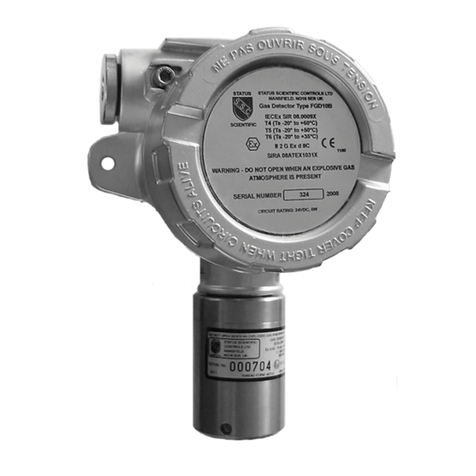
STATUS SCIENTIFIC CONTROLS
STATUS SCIENTIFIC CONTROLS FGD10B Series User manual

STATUS SCIENTIFIC CONTROLS
STATUS SCIENTIFIC CONTROLS FGD 3 Series User manual
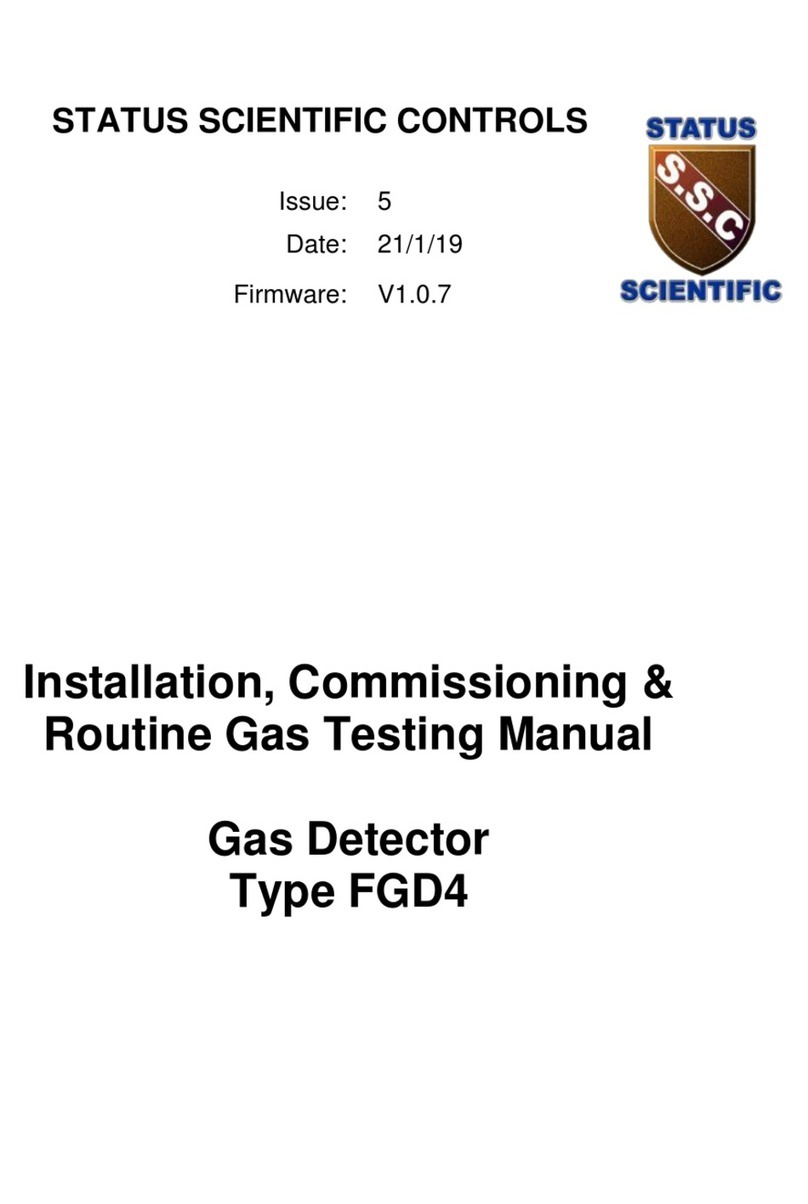
STATUS SCIENTIFIC CONTROLS
STATUS SCIENTIFIC CONTROLS FGD4 User manual

STATUS SCIENTIFIC CONTROLS
STATUS SCIENTIFIC CONTROLS FGD10A User manual

STATUS SCIENTIFIC CONTROLS
STATUS SCIENTIFIC CONTROLS FGD10B Series Guide
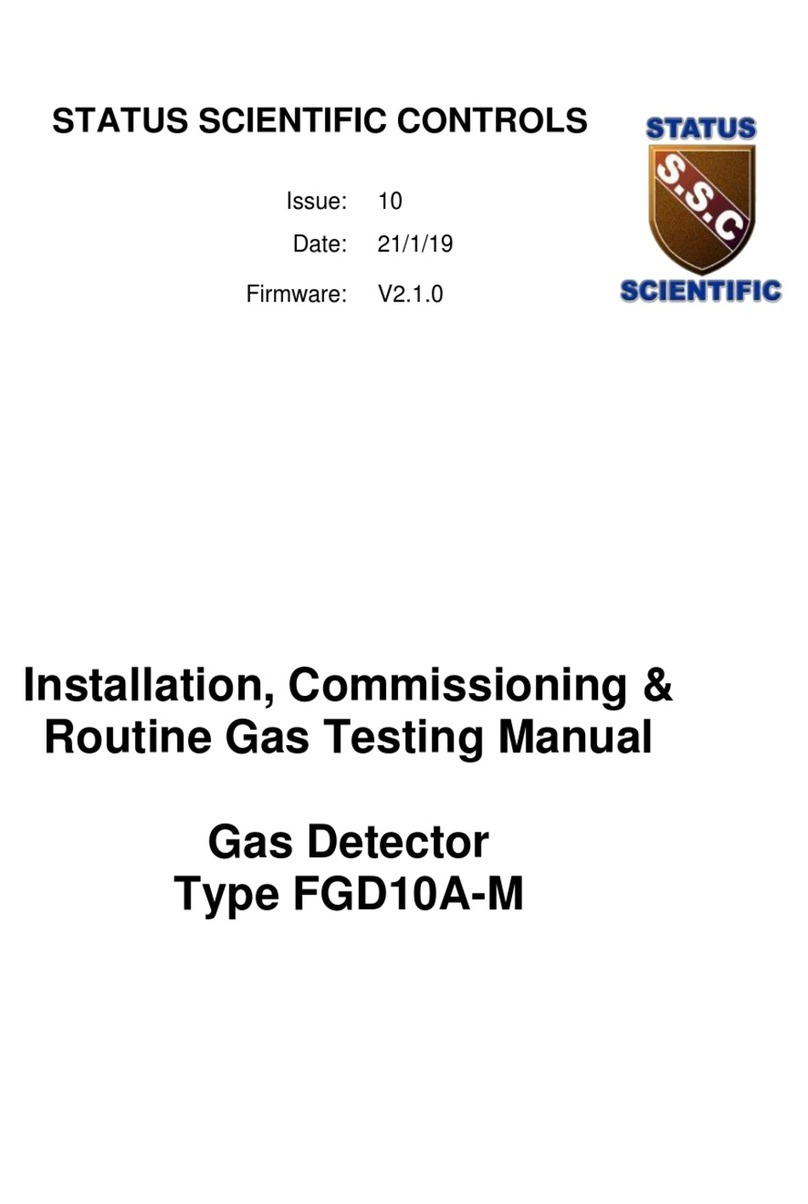
STATUS SCIENTIFIC CONTROLS
STATUS SCIENTIFIC CONTROLS FGD10A-M User manual
